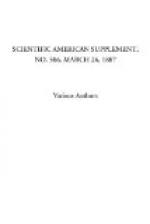The tourteau goudronne (lit. “tarred coke”) is merely a ring formed of old lunt or of cords well beaten with a mallet (Fig. 10). This ring is first impregnated with a composition formed of 20 parts of black pitch and 1 of tallow, and then with another one formed of equal parts of black pitch and resin. One of these torches will burn for an hour in calm weather, and half an hour in the wind. Rain does not affect the burning of it. These rings are usually arranged in pairs on brackets with two branches and an upper circle, the whole of iron, and these brackets are spaced a hundred yards apart.
[Illustration: FIGS. 9 TO 16.—VARIOUS PYROTECHNIC DEVICES.]
[Illustration: FIGS. 17.—ILLUMINATING ROCKET.]
A tarred fascine consists of a small fagot of dry wood, 20 inches in length by 4 in diameter, covered with the same composition as the preceding (Fig. 11). Fascines thus prepared burn for about half an hour. They are placed upright in supports, and these latter are located at intervals of twenty yards.
The Lamarre compositions are all formed of a combustible substance, such as boiled oil,[1] of a substance that burns, such as chlorate of potash, and of various coloring salts.
[Footnote 1: For preparation see page 9304 of SUPPLEMENT.]
The white composition used for charging fire balls and 11/2 inch flambeaux is formed of 500 parts of powdered chlorate of potash, 1,500 of nitrate of baryta, 120 of light wood charcoal, and 250 of boiled oil. Another white composition, used for charging 3/4 inch flambeaux, consists of 1,000 parts of chlorate of potash, 1,000 of nitrate of baryta, and 175 of boiled oil.
The red composition used for making red flambeaux and percussion signals consists of 1,800 parts of chlorate of potash, 300 of oxalate of strontia, 300 of carbonate of strontia, 48 of whitewood charcoal, 240 of boiled oil, 6 of oil, and 14 of gum lac.
A red or white Lamarre flambeau consists of a sheet rubber tube filled with one of the above-named compositions. The lower extremity of this tube is closed with a cork. When the charging has been effected, the flambeau is primed by inserting a quickmatch in the composition. This is simply lighted with a match or a live coal. The composition of the Lamarre quickmatch will be given hereafter.
A Lamarre flambeau 11/2 inch in diameter and 3 inches in length will burn for about thirty-five minutes. One of the same length, and 3/4 inch in diameter, lasts but a quarter of an hour.
A fire ball consists of an open work sack internally strengthened with a sheet iron shell, and fitted with the Lamarre white composition. After the charging has been done, the sphere is wound with string, which is made to adhere by means of tar, and canvas is then wrapped around the whole. Projectiles of this kind, which have diameters of 6, 8, 11, and 13 inches, are shot from mortars.




